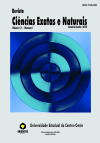Modelagem da distribuição diamétrica de quatro espécies de Lauraceae em um fragmento de Floresta Ombrófila Mista.
Palavras-chave:
Distribuição probabilística, Modelagem, Teste de aderência, Ocotea spp., Nectandra spp.Resumo
O presente estudo teve como objetivo ajustar e selecionar funções de densidade de probabilidade que descrevam a distribuição diamétrica de quatro espécies de Lauraceae existentes em um fragmento de Floresta Ombrófila Mista. Os dados usados no ajuste das funções provêem do censo realizado em um fragmento de 15,24 ha, conhecido como “Capão da Engenharia Florestal”, localizado no Campus Jardim Botânico da UFPR, Curitiba-PR, em que foram medidas, marcadas, identificadas e georreferenciadas todas as árvores com DAP acima de 10 cm. Foram então ajustadas as funções probabilísticas de Weibull 2 e 3 parâmetros, Gamma, Gamma (adaptada), Sb de Johnson, Beta, Weber, Péllico, e as Exponenciais de Meyer tipo I, e tipo II. As funções foram ajustadas pelo método dos mínimos quadrados, utilizando um intervalo de classe de 5 cm. Os critérios de seleção utilizados foram o teste de Kolmogorov-Smirnov e a soma de quadrados dos resíduos. De acordo com estes critérios, a função de Weber foi a que melhor descreveu a distribuição diamétrica de Ocotea bicolor Vattimo e Nectandra lanceolata Ness. Para Ocotea nutans (Nees) Mez e Ocotea puberula (Reich.) Ness, os modelos que melhor representaram sua distribuição foram as funções Weibull 3 parâmetros e Sb de Johnson, respectivamente.
Downloads
Publicado
Edição
Seção
Licença
Autores mantém os direitos autorais e concedem à revista o direito de primeira publicação, com o trabalho simultaneamente licenciado sob a Creative Commons Attribution License que permitindo o compartilhamento do trabalho com reconhecimento da autoria do trabalho e publicação inicial nesta revista.
Esta revista proporciona acesso público a todo seu conteúdo, seguindo o princípio de que tornar gratuito o acesso a pesquisas gera um maior intercâmbio global de conhecimento. Tal acesso está associado a um crescimento da leitura e citação do trabalho de um autor. Para maiores informações sobre esta abordagem, visite Public Knowledge Project, projeto que desenvolveu este sistema para melhorar a qualidade acadêmica e pública da pesquisa, distribuindo o OJS assim como outros software de apoio ao sistema de publicação de acesso público a fontes acadêmicas. Os nomes e endereços de e-mail neste site serão usados exclusivamente para os propósitos da revista, não estando disponíveis para outros fins.

